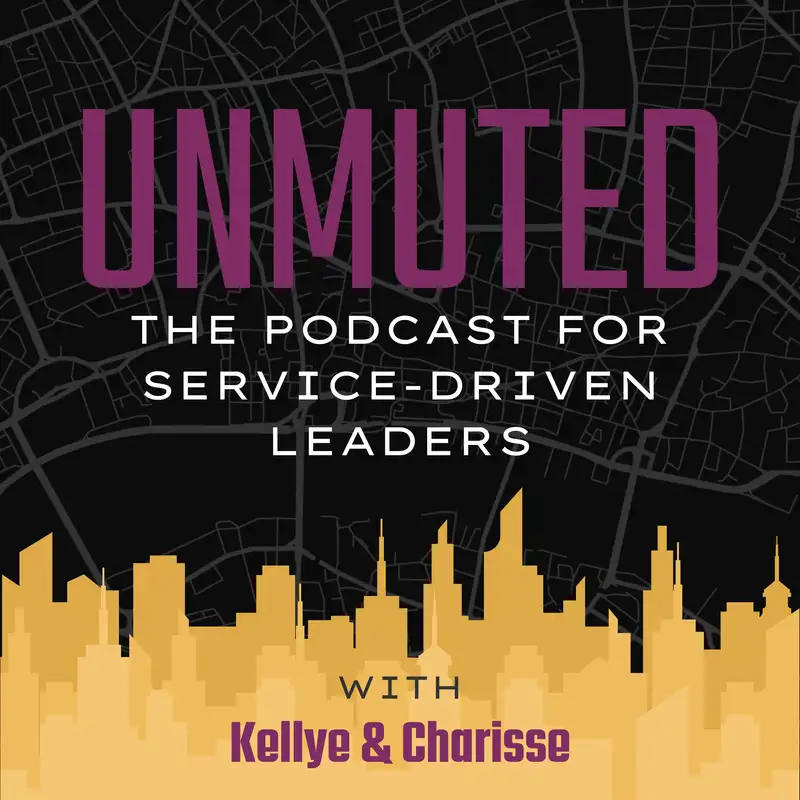Kellye Mazzoli (00:34)
Hello and welcome back to another episode of Unmuted. Today's episode is about open to work with a little green banner on LinkedIn is actually saying, know, Charisse, the other day, what caught me was that I had two different clients talk to me about the little green banner on LinkedIn saying that either they were open to work or they had an employee.
who had posted that they were open to work. And so anyway, I went on LinkedIn and I was just casually scrolling and I saw someone that I used to work with, a colleague of mine that actually had that green banner that said open to work on their profile. And so while it isn't a shock, I mean, it's obviously something that's happening quite often, I still felt like, hmm, like what's going on? Why is that person back on the job market? I mean, I wonder what's happening with their Council.
Has it really gotten that bad? So I see this banner personally as a signal, as a flag, and it's not necessarily a red flag, right? But it is a flag and it's waving and signaling something. And so that's what I wanna talk with you about today.
Charisse Deschenes (01:44)
that's so important to look at it that way because it's not just about job searching. We know, especially in the spaces that we work in, government, public service, that mission-driven work, these places are where people do, they don't post something lightly, right? It's a risk when they put their neck out on the line to post that.
Kellye Mazzoli (02:07)
absolutely the perfect word, right? Risk. But there's always a story behind it, right? You don't just wake up one day and think, you know what? I'd love to make this public declaration that I'm done here. Right? And I mean, here's the funny thing. What I've noticed and I can say from experience with my coaching clients is that it's usually been months, if not even years, of not being seen, not being valued, of slowly just sort of
Charisse Deschenes (02:18)
Right. Yeah.
Kellye Mazzoli (02:34)
It takes time though, and it finally hits you. Like, you know what, I gotta put it on. I gotta be open to work. But you're already halfway out the door, right? You've been working through this for a really long time.
Charisse Deschenes (02:46)
Right. it's sometimes that's the bravest thing that you can actually do or that you, you you it's the first moment they say, I'm not okay here. Maybe it's a request. You're thinking it's like, it's a boundary. Maybe it's a breadcrumb. And I think a lot of leaders are maybe reading it wrong.
Kellye Mazzoli (03:04)
Yeah, let's dive into that. Okay, so first let's talk just a little bit about what this banner is in case somebody doesn't happen to know what it is. And let's also maybe talk a little bit about what it isn't. Technically, LinkedIn will let you either privately tell recruiters that you're looking or LinkedIn will allow you to go fully public that you are looking for another job opportunity.
Charisse Deschenes (03:06)
Yeah. Yeah.
Kellye Mazzoli (03:29)
And so if you go public, if you click that and you say you're open to work and you want to go public, not just to tell the recruiters, then your photo gets this green circle and the words open to work around it. So it's very, very visible.
Charisse Deschenes (03:42)
Right, right. And for some people, the visibility is empowering, especially if you're laid off or your mid-career pivot is just around the corner. You're telling the world that. But when you're still employed, right, that green circle is like a flare gun. It's like you're shooting it into the sky saying, hey, I'm not okay. I need someone to see this, you know?
Kellye Mazzoli (04:08)
Right. And in other industries, maybe this is something that is more typical or understandable or, you know, people expect it more. But what's wild is that in places like government, feel, especially local government, that there's this unspoken rule that you're not really allowed to want out. Right. Like you're supposed to be loyal. You're supposed to keep your head down. You're supposed to ride it all out.
Charisse Deschenes (04:31)
Alright.
Kellye Mazzoli (04:33)
So when somebody actually makes that move and puts it out there, it really does say something. Not just I'm looking, but maybe I tried to stay, I asked for more, but I'm not getting it. I don't feel safe saying this anywhere else. Or maybe even I'm a little desperate to get the heck out of here, right? I read a little bit of urgency into it, so.
Charisse Deschenes (04:53)
Yeah.
Kellye Mazzoli (04:56)
So why do some people use it? I would say, like I've had coaching clients that have used it. I've also had, like I said, coaching clients who have had their employees use it. But for those ones that use it themselves personally, they've been trying to convince themselves to stay. They rationalized it, they've reframed it, they've gotten new titles. But that didn't fix the culture. And finally, they're like, I'm done. I need out, and I'm not gonna hide that anymore.
Charisse Deschenes (05:22)
And so it's that empowering move like we were talking about earlier that you're really taking control of your own story. And when you're in an organization where nobody's asking you how you're doing, or when you're overextended, under recognized, where the politics is really thick and compassion maybe then, sometimes that green banner is the only safe space to be honest. You know, it's where
Kellye Mazzoli (05:46)
Yeah.
Charisse Deschenes (05:48)
It's where you go and you're thinking there's a little bit of hope here.
Kellye Mazzoli (05:54)
Maybe, yeah. And maybe that gets missed, right? Because whenever I see it, I don't automatically go, this person's reclaiming agency. It's like, you know, or trying to tell us something about their employment status. I mean, it's like, I'm trying to get out. I'm stuck. That's what I see. That's the signal I'm seeing. So maybe though, whenever you're posting it, what you get out of it is that it signals to yourself. It's like a little contract with your future self saying, I'm not stuck and I can move and I'm gonna approve it.
Charisse Deschenes (05:58)
Mm-hmm.
⁓
Yeah, yeah, it's not always that burnout. Sometimes it's just that clarity, like you're saying. It's a growth in who they are, where they're going with their career, how they stand up and say, this is not okay.
Kellye Mazzoli (06:39)
Right, yeah. So let's dive a little bit into what leaders might misread and ⁓ maybe what they should do instead, right? So if you're a leader and somebody has posted it, maybe it's your top employee, ⁓ right? Your star employee and you go on and you see it you're like, like a little panic, maybe there's some, I feel blindsided, maybe you get mad.
Charisse Deschenes (06:47)
Yeah.
Mm-hmm.
Kellye Mazzoli (07:06)
Right? Like that's a common reaction. Like dang it, like this is supposed to be my person and they're just up and in trying to leave on me. You know, or maybe even you wonder like, why didn't they come to me first?
Charisse Deschenes (07:06)
Right.
Yeah. And, you know, saying it plainly, like, if someone you value is posting in the banner and you're shocked, they probably did try to tell you something. And maybe it's not direct, maybe not in so many words, but they gave you signs and they pulled back, they asked questions. Maybe they tried to renegotiate, you know, the relationship with the job. And at some point they gave up on being heard.
Kellye Mazzoli (07:45)
Mm-hmm. Mm-hmm. So even if you're mad at them, like maybe think about, you know, maybe they did try to reach out to me. Maybe they did try to see me. So if you see it as a leader and it's one of your employees, here's what I say you don't do. I think let's start with the don'ts. Number one, like don't retaliate.
Charisse Deschenes (08:01)
Sure.
Kellye Mazzoli (08:06)
Maybe your feelings are hurt, maybe you're a little angry, but retaliation is definitely not gonna get this employee to stay, especially if you value them and you value their contributions on the team. That's probably the worst thing. And maybe retaliate is a strong word, but you know what I mean. The other thing is, is don't ice them out. Just because they posted the banner doesn't mean that there isn't still...
Charisse Deschenes (08:22)
Yeah.
Kellye Mazzoli (08:32)
the ability to salvage a relationship at some level, even if they do still go in the end, but maybe there's a learning opportunity here for you as a leader, right? We sometimes forget that, but we're all still growing, we're all still human. So don't ice them out and don't shame them by thinking ⁓ that they've been disloyal, right? Like, ⁓ these people are not loyal. They're just off to the next bigger, better thing.
Charisse Deschenes (08:43)
Mm hmm. Right.
Right.
Right. Yeah. Yeah.
Yeah, and internalize that a little bit. You're the leader here. Take the responsibility to maybe sit down with that person and say, I see that you changed your status on LinkedIn. I'm you know, I'm curious about that. Be curious in the moment and talk with them. You know, is it something you want help with on your next chapter? Is there an opportunity here that we might work with you? But being open to have that conversation with your employee.
would give you the opportunity to build on someone that might be, you know, that has an opportunity within your organization or it might also help them move on to the next job, which would be great for them.
Kellye Mazzoli (09:44)
Right, right, yeah, like be a grownup. And I'm gonna say something that's probably not gonna be super well liked here, but it's like, if you're not ready to have that conversation with the employee, then maybe you're not ready to actually lead.
Charisse Deschenes (09:47)
Be grown up, yes, absolutely.
Kellye Mazzoli (10:04)
And I don't know, is it harsh?
Charisse Deschenes (10:04)
poignant, Kelly.
No, I don't think that's harsh. I think that's very honest. how many of us, when you look internally, really reflect and say, OK, this is on me. I need to take this responsibility. This is on my shoulders. And to some degree, like you said, it's the employees' opportunity to also
Kellye Mazzoli (10:25)
Yeah.
Charisse Deschenes (10:33)
have that conversation and really know, you know, what's the direction that we're going with me so they have a clarity on where they stand within that organization.
Kellye Mazzoli (10:42)
Yeah, yeah, I think ultimately, you know, again, so maybe that won't be the the best way to put it. But I think you have to question yourself constantly as a leader because we're all human. We all need to grow. We don't know everything. New situations present themselves. New technologies are arriving. We have so many things. And if we're not curious and we're not stepping back and being human.
and enacting a little grown up and holding our own selves accountable. Like how can we expect to hold others accountable? How can we expect others to take full responsibility and accountability if we're not even willing to do it ourselves? We have a hand in this too. So I just want to point that out for leaders that I think it's really important for you to have that hard conversation with that employee about, like, why are you really looking to leave? It's not always about keeping them. It's not always about convincing them to stay.
But having that conversation may help you grow and be an even better leader in the future with your other employees.
Charisse Deschenes (11:45)
Yeah. ⁓
Kellye Mazzoli (11:47)
Yeah.
So I'd just say, like, if you're listening to this and you're hovering over that open to work button and ⁓ let's ask, let's, let's start with a few questions that I think will help you determine whether or not you should press the button. So the first thing I would do is ask. So it's this curiosity that you brought up, Charisse. So I'm just going to play right into that because that's my favorite thing. If anybody's coached with me one on one, then you know, I always say, be curious, be curious, be curious. It comes out quite a bit.
Charisse Deschenes (12:11)
Mm-hmm.
Kellye Mazzoli (12:15)
But the first question to ask yourself to maybe journal on is, am I doing this from burnout or am I doing this from clarity? Am I doing this because I'm so exhausted and I just can't take anymore or am I doing this because I do realize that my values do not align with the values of this organization any longer? The second question I would ask is, have I given myself the conversation I haven't had with anyone else?
Have I given myself the conversation I haven't had with anyone else? So if I'm the one looking to press go, if I'm a city manager, have I had a conversation, an honest conversation with that mayor? If I'm an assistant city manager, have I sat down and had an honest conversation? Like a real open, honest conversation with my city manager? Have I had the conversation I need to have? The third question I would say is, am I ready for this and what it signals publicly? And am I gonna be okay with that?
So for every action that you take, there's no right or wrong decision here, but there are consequences. So think about those consequences and ask, hey, if I'm signaling this publicly, I ready to pull the plug on this job? Am I really ready to go? Am I really ready to go?
Charisse Deschenes (13:28)
Right, right. you know, if the answer is yes, then you need to own that, right? Let the banner reflect something that you've already processed, not something that you're hoping will start the conversation for you. You have to be able to see.
the impact of hitting that button and what that is. And so you do, you own it, you reflect on it, and then move forward.
Kellye Mazzoli (13:58)
Yeah, I love that. I mean, you're really talking about empowerment, empowering yourself and owning that, whether you press go or you don't, whether you choose to signal it publicly or you don't. I would also mention too is that I don't think that the banner is a fix. Right. It's not going to fix everything. It's not going to automatically get you a job. It is automatically going to get you out of the situation, but it is a flag. So if you're hoping that it will save you.
Charisse Deschenes (14:10)
Yeah.
Kellye Mazzoli (14:25)
I would just offer that you're not actually leading yourself.
Charisse Deschenes (14:30)
Right. Yeah. So the green banner does matter, right? It's not because it's dramatic, but because it's often the first moment someone finally tells the truth.
Kellye Mazzoli (14:43)
Yeah, and signals that. And hopefully as a leader, if you're seeing it in one of your employees, like you're seeing that signal and you're seeing that it means that it's time to have that more difficult conversation. As leaders, as colleagues, as humans, wouldn't we all be better off if we just stopped waiting for that green banner and instead ask, hey, are you okay? Do you actually still want to be here? Right? Are we creating environments where people want to be?
Charisse Deschenes (15:09)
Yeah.
Kellye Mazzoli (15:11)
Are we creating organizations where people want to be? Isn't that our job as leaders?
Charisse Deschenes (15:16)
Great question, Kelly. the people that you lead are watching you not just in how you respond to their success, but in how you respond to their leading.
Kellye Mazzoli (15:26)
Yeah, and if you're the one thinking about leaving, the one with the draft post in your browser right now, right on LinkedIn, let this be your episode, let this be your permission to stop waiting for the perfect moment and start listening to that truth that you already know, right? Ask yourself those questions and determine if it's time to press go.
Charisse Deschenes (15:44)
Yes.
Yes. So we'll see you next time. Until then, stay brave, stay grounded, and stay unmuted.


